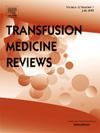个性化输血策略:可穿戴生物传感器在慢性贫血管理中的新作用
IF 2.5
2区 医学
Q2 HEMATOLOGY
引用次数: 0
摘要
慢性输血依赖性贫血在优化症状控制和功能结果方面提出了持续的挑战,特别是在老年,通常合并症患者组中。基于固定血红蛋白阈值的传统输血策略可能不足以解决氧气输送需求和症状负担的个体差异。可穿戴生物传感器技术可以在现实环境中持续监测心率、呼吸频率和身体活动等生理参数。这些工具提供了发现早期恶化的潜力,支持更及时、以患者为中心的输血决策,并提高血液警惕性。这篇综述评估了生物传感器在输血医学中应用的可行性、可接受性和临床相关性的现有证据。最近的初步研究结果表明,高数据质量,良好的耐受性和输血后生理反应的初步适应症。然而,生物传感器引导输血策略的临床应用仍未得到证实,主要挑战包括数据解释、工作流程整合和临床有意义终点的验证。随着该领域向个性化支持护理的发展,生物传感器可能提供一种优化输血时机、保持功能能力和提高生活质量的新方法。本文章由计算机程序翻译,如有差异,请以英文原文为准。
Toward Personalized Transfusion Strategies: The Emerging Role of Wearable Biosensors in Chronic Anemia Management
Chronic transfusion-dependent anemia presents ongoing challenges in optimizing symptom control and functional outcomes, particularly in an older, often comorbid patient group. Conventional transfusion strategies based on fixed hemoglobin thresholds may inadequately address the individual variability in oxygen delivery needs and symptom burden. Wearable biosensor technologies enable continuous monitoring of physiological parameters such as heart rate, respiratory rate, and physical activity in real-world settings. These tools offer the potential to detect early deterioration and support more responsive, patient-centered transfusion decisions and improve hemovigilance. This review evaluates current evidence on the feasibility, acceptability, and clinical relevance of biosensor use in transfusion medicine. Findings from recent pilot studies demonstrate high data quality, favorable tolerability, and preliminary indications of physiological response following transfusion. However, the clinical utility of biosensor-guided transfusion strategies remains unproven, with key challenges including data interpretation, workflow integration, and validation of clinically meaningful endpoints. As the field moves toward personalized supportive care, biosensors may offer a novel means to optimize transfusion timing, preserve functional capacity, and enhance quality of life.
求助全文
通过发布文献求助,成功后即可免费获取论文全文。
去求助
来源期刊

Transfusion Medicine Reviews
医学-血液学
CiteScore
11.60
自引率
0.00%
发文量
40
审稿时长
21 days
期刊介绍:
Transfusion Medicine Reviews provides an international forum in English for the publication of scholarly work devoted to the various sub-disciplines that comprise Transfusion Medicine including hemostasis and thrombosis and cellular therapies. The scope of the journal encompasses basic science, practical aspects, laboratory developments, clinical indications, and adverse effects.
 求助内容:
求助内容: 应助结果提醒方式:
应助结果提醒方式:


